The Rho Ophiuchi cloud complex is a large complex of bright and dark nebulae located in the constellation Ophiuchus. It is located approximately 460 light-years away and centred 1 degree south of the star system Rho Ophiuchi. The complex of interstellar clouds is one of the nearest star-forming regions to the Sun.
The Rho Ophiuchi cloud complex covers an area 4.5 by 6.5 degrees across and extends into the neighbouring constellation Scorpius. It appears just north of Antares and is one of the most popular astrophotography targets in the night sky. The stellar nursery was imaged by NASA and ESA’s James Webb Space Telescope (JWST) on its first anniversary in July 2023.
The Rho Ophiuchi complex consists of two major star-forming regions of dense gas and dust. One of these regions contains the cloud Lynds 1688 (L1688) and the filaments L1709 and L1755, while the other is home to the star-forming nebula L1689 and the filament catalogued as L1712-L1729.
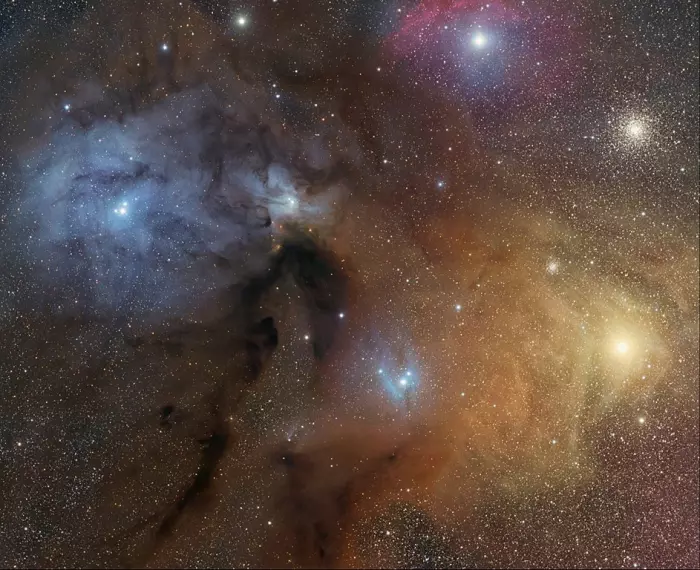
The Rho Ophiuchi cloud complex is a dark nebula of gas and dust that is located 1° south of the star ρ Ophiuchi. At an estimated distance of 131 ± 3 parsecs, this cloud is one of the closest star-forming regions to the Solar System. This cloud covers an angular area of 4.5° × 6.5° in the sky. The brightest star in this image is Antares (Alpha Scorpii or α Sco), the fifteenth brightest star in the sky and the brightest star in the constellation Scorpius. Image credit: Leonardo Ciuffolotti, Matteo Collina, Riccardo De Benedictis, Giuseppe Donatiello, Rolando Ligustri (CC0 1.0)
The large main cloud of molecular hydrogen (L1688) is a stellar nursery in which new stars form. The filaments of the Rho Ophiuchi region stretch up to 32.6 – 57 light-years (10 – 17.5 parsecs) across and are as narrow as 0.78 light-years (0.24 parsecs) in places.
Two large dark nebulae, catalogued as Barnard 44 (B44) and Barnard 45 (B45) appear just east of the Rho Ophiuchi molecular cloud and Antares. Nicknamed the Dark River, Barnard 44 lies 500 light-years away and stretches about 10 degrees, or 100 light-years. It stretches all the way to the Pipe Nebula (B59, 65-67 and 78), a dark cloud within the larger Dark Horse Nebula that obscures part of the Milky Way’s band. Barnard 44 and 45 are known as the Rho Ophiuchi Streamers or Dark River clouds.
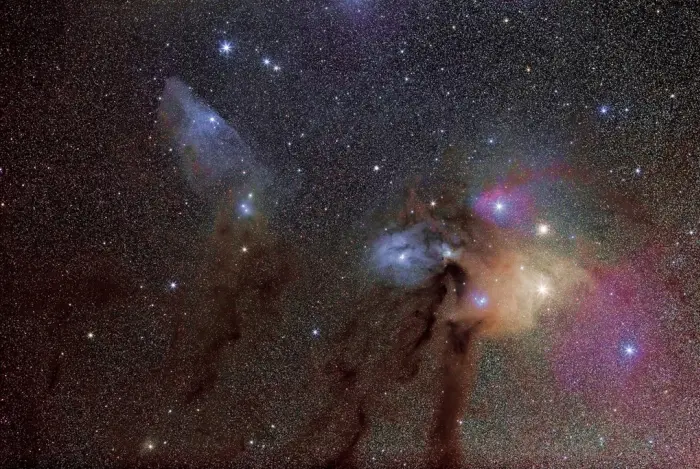
Wide field photo showing the nebulosity surrounding the Rho Ophiuchi cloud complex. Image created with 35 × 31 stacked 180 second (total 105 minutes) sub-exposures taken with a stock Canon EOS 5D Mark II and 135 mm f/2L lens at f/4 and ISO 1600, stacked using Deep Sky Stacker and finished in Adobe Photoshop CS5. Image: Wikimedia Commons/Naskies (CC BY-SA 3.0)
Lynds 1688, the main cloud of the Rho Ophiuchi cloud complex, contains more than half the mass of the complex. It is the most active star-forming region in the Rho Ophiuchi complex. Observations in infrared wavelengths have revealed 425 infrared sources near it. These sources are young stellar objects, 16 of which have been identified as protostars. These are dense balls of gas that have not yet accreted all their mass and are still embedded in their parent clouds. They are still gathering material from the dusty disks of gas that surround them. These disks may also give birth to planets.
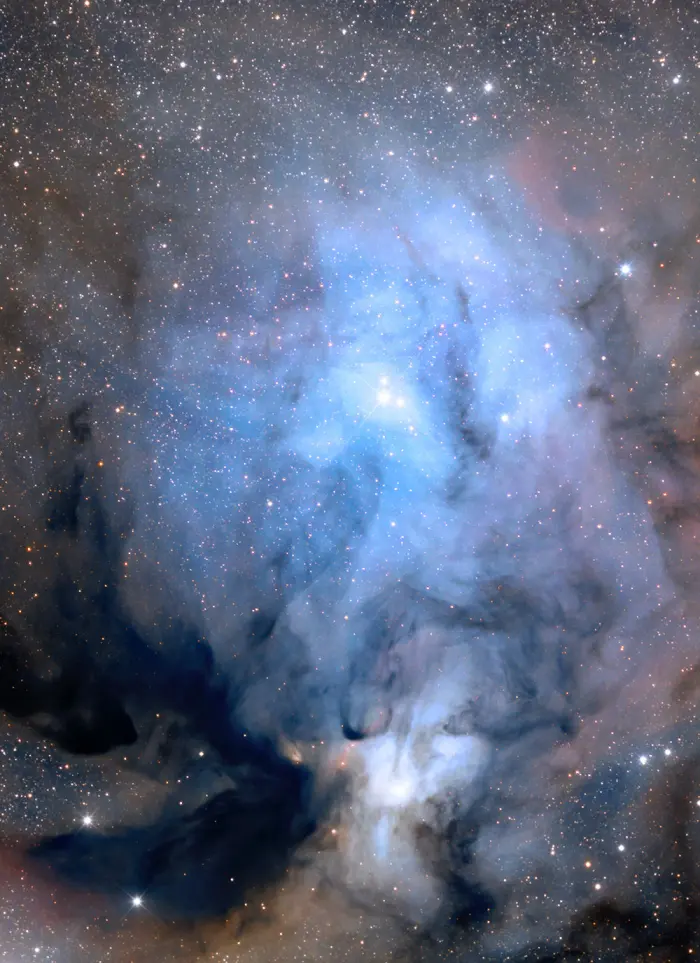
LDN 1688, image credit: Adam Block/Steward Observatory/University of Arizona (CC BY-SA 3.0)
Astronomers have also detected around 200 T Tauri stars in the cloud. These are the youngest visible stars with masses comparable to that of the Sun. These stars have shed their disks and, unlike protostars, they can be seen in visible light. Scientists identified 123 T Tauri stars with thick circumstellar disks and 77 T Tauri stars with thinner disks. These stars have estimated ages between 100,000 years and 1 million years.
In 2002, a team led by Nicolas Grosso of the Max Planck Institute in Germany reported the discovery of a circumstellar disk with a diameter of 300 astronomical units and a mass twice that of Jupiter. The object was nicknamed the Flying Saucer. It was found at the edge of a dark cloud in the Rho Ophiuchi region.
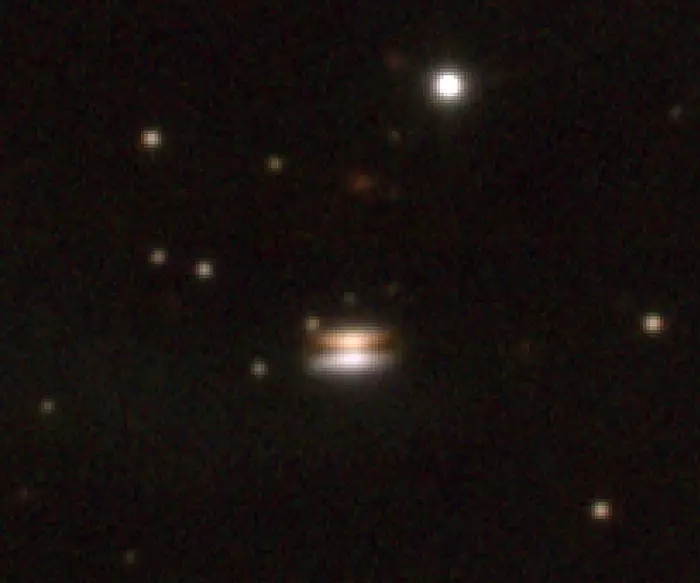
Using the ESO 3.5-m New Technology Telescope and the Very Large Telescope (VLT) , a team of astronomers have discovered a dusty and opaque disk surrounding a young solar-type star in the outskirts of a dark cloud in the Milky Way. It was found by chance during an unrelated research programme and provides a striking portrait of what our Solar System must have looked like when it was in its early infancy. Because of its striking appearance, the astronomers have nicknamed it the “Flying Saucer.” Image credit: ESO (CC BY 4.0)
The object is a good example of a young star with a disk in which planets will soon form. Our own solar system may have looked like this when it was in its early infancy. The object was discovered using the ESO 3.5-m New Technology Telescope and the Very Large Telescope (VLT) on April 7, 2001. The central star has a temperature of 3,000 K and a luminosity 0.4 times that of the Sun.
Star formation in the Rho Ophiuchi region was triggered by a supernova that occurred about 1.5 million years ago and sent a powerful shock wave through the Ophiuchus clouds. Like Rho Ophiuchi, the progenitor star was a member of the Upper Scorpius subgroup of the Scorpius-Centaurus association, the nearest OB association to the Sun.
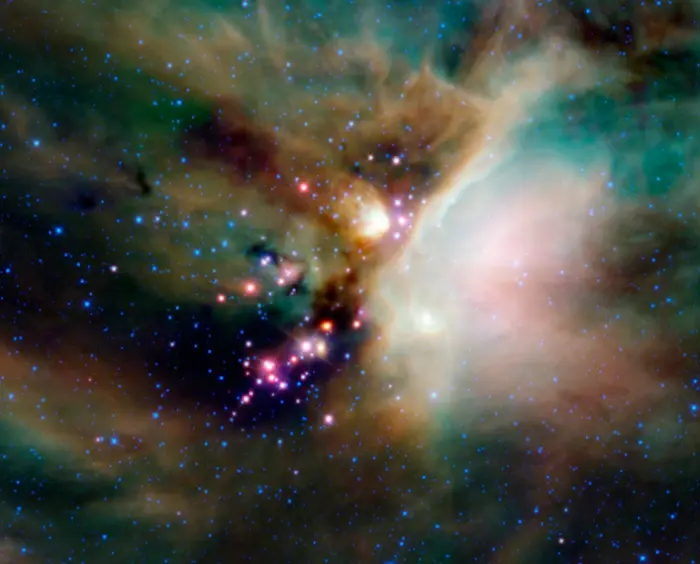
The bright pink objects around the center are young stellar objects (YSOs) located in the Rho Ophiuchi cloud complex. These baby stars are just now forming; many of them are still enveloped in their own tiny compact nebulae. In visible light, these YSOs are completely hidden in the dark nebula that surrounds them, which is sometimes referred to as their baby blanket. The very bright region just above center is part of the cloud illuminated by the T-Tauri star 2MASS J16263416-2423282. The bright but diffuse area just right of center is an area illuminated by the YSO 2MASS J16260931-2434121. Image credit: NASA/JPL-Caltech/WISE Team
Rho Ophiuchi
Rho Ophiuchi is a multiple star system with a combined apparent magnitude of 4.63. If it were not surrounded by the region of gas and dust, it would shine at magnitude 3.18. The interstellar extinction makes the star system appear 1.45 magnitudes fainter than it is.
Rho Ophiuchi lies approximately 360 light-years away. The system is composed of a visual binary star referred to as Rho Ophiuchi AB. The two components, both hot blue B-type stars, are separated by 3.1 arcseconds, or at least 344 astronomical units (Earth-Sun distances). They have an orbital period of about 2,398 years.
The system has several other components. Rho Ophiuchi C is separated by 2.5 arcminutes from the main pair and Rho Ophiuchi DE is 2.82 arcminutes away. The components C and D are both class B main sequence stars. The component D is itself a binary star whose two components orbit each other with a period of around 675.5 years.
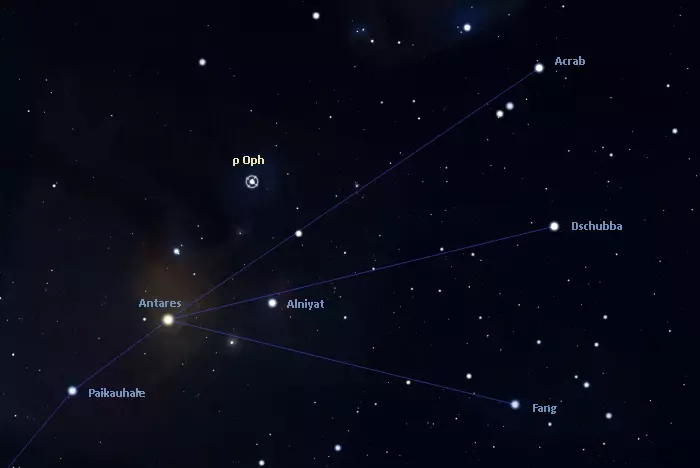
The location of Rho Ophiuchi, image: Stellarium
The primary component, Rho Ophiuchi A, has a mass 9.6 times that of the Sun and a radius of 8.5 solar radii. With an effective temperature of 21,900 K, it is 13,000 times more luminous than the Sun. The star is a rapid rotator, with a projected rotational velocity of around 240 km/s.
The other four known components are also more massive than the Sun, with masses of 8 (ρ Oph B), 5 (ρ Oph C), 3.06 (ρ Oph D), and 1.97 (ρ Oph E) solar masses.
The Rho Ophiuchi star system is surrounded by the blue reflection nebula IC 4604, sometimes called the Rho Ophiuchi Nebula.
IC 4604 is one of the several relatively bright reflection nebulae in the region. IC 4603 and IC 4605, two other reflection nebulae, are found in the area between Rho Ophiuchi and Antares. IC 4605 surrounds the star 22 Scorpii and IC 4603 the star HD 147889 (SAO 184376). Both stars have the spectra of hot blue main sequence stars of the spectral type B. The Simbad database lists HD 147889 as a young stellar object (YSO).
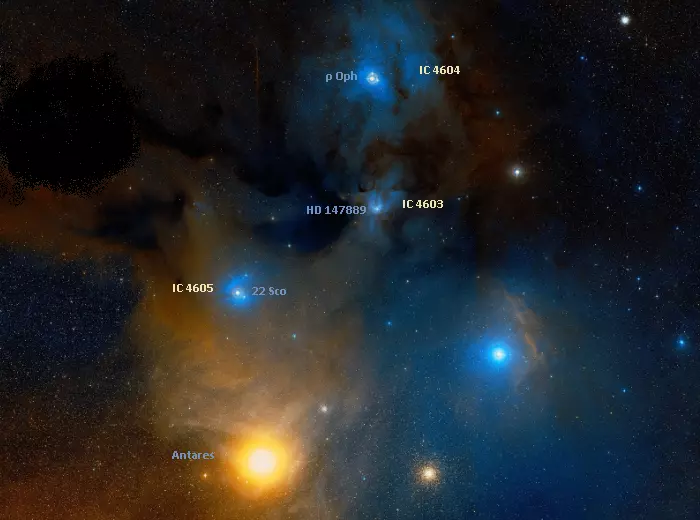
The reflection nebulae IC 4603, IC 4604 and IC 4605 in the Rho Ophiuchi region, image: Wikisky
Facts
The first brown dwarf to be detected in a star forming region was discovered in the Rho Ophiuchi molecular cloud. It was catalogued as Rho Oph J162349.8-242601. The brown dwarf was discovered by Rieke & Rieke in 1990. The astronomers suggested that it may be a foreground star due to little reddening. However, later observations strongly supported membership of the Rho Ophiuchi region.
Observations with the Red Channel Spectrograph at the Multiple Mirror Telescope on Mount Hopkins in 1997 revealed a spectral type of M8.5 ± 0.5 for the object as well as strong Hα emission. Astronomers derived a mass of 0.01 – 0.06 solar masses, indicating a substellar object. The brown dwarf has an estimated age of 3 – 10 million years.
In 2012, observations with the Atacama Large Millimeter Array (ALMA) led to the discovery of glycolaldehyde, a simple form of sugar, in the gas surrounding the young binary system catalogued as IRAS 16293–2422 in the Rho Ophiuchi cloud complex. This was the first time that sugar has been detected around a solar-type star. The binary system is composed of at least two protostars separated by 700 astronomical units.
Astronomers also found chloromethane in the interstellar medium surrounding IRAS 16293–2422, which was another first discovery. Additionally, the accretion disk surrounding the star system was found to have parts rotating in opposite directions, which means that, once planets form, the inner planets may orbit the parent star in the opposite direction to the outer planets.
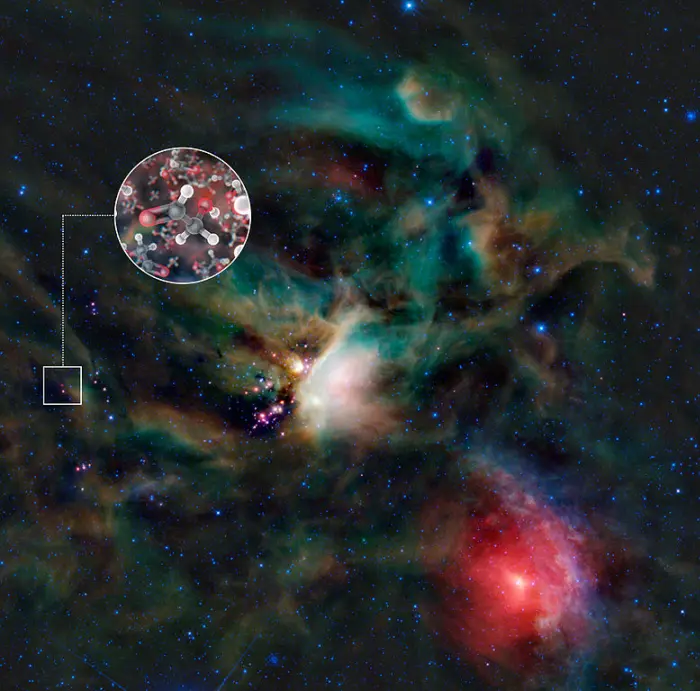
A team of astronomers has found molecules of glycolaldehyde — a simple form of sugar — in the gas surrounding a young binary star, with similar mass to the Sun, called IRAS 16293-2422. This is the first time sugar been found in space around such a star, and the discovery shows that the building blocks of life are in the right place, at the right time, to be included in planets forming around the star. The astronomers used the Atacama Large Millimeter/submillimeter Array (ALMA) to detect the molecules. This image shows the Rho Ophiuchi star-forming region in infrared light, as seen by NASA’s Wide-field Infrared Explorer (WISE). IRAS 16293-2422 is the red object in the centre of the small square. The inset image is an artist’s impression of glycolaldehyde molecules, showing glycolaldehyde’s molecular structure (C2H4O2). Carbon atoms are shown as grey, oxygen atoms as red, and hydrogen atoms as white. In the WISE infrared image of Rho Ophiuchi, blue and cyan represent light emitted at wavelengths of 3.4 and 4.6 micrometres, which is predominantly from stars. Green and red represent light from 12 and 22 micrometres, respectively, which is mostly emitted by dust. Image credit: ALMA (ESO/NAOJ/NRAO)/L. Calçada (ESO) & NASA/JPL-Caltech/WISE Team (CC BY 4.0)
James Webb Space Telescope image
The Rho Ophiuchi cloud complex was imaged by the James Webb Space Telescope in July 2023. The image was released on the telescope’s first anniversary. It revealed very young stars surrounded by circumstellar disks in which planetary systems will eventually form. The image also showed jets emanating from the new stars and colliding with the surrounding interstellar gas and exciting molecular hydrogen.
The most massive of these stars, designated S1, is visible in the lower half of the Webb image. The gas surrounding the young star consists of carbon-based molecules known as polycyclic aromatic hydrocarbons (PAHs). The organic compounds may have been the starting materials in the synthesis of materials required by the earliest forms of life, but this hypothesis is still untested.
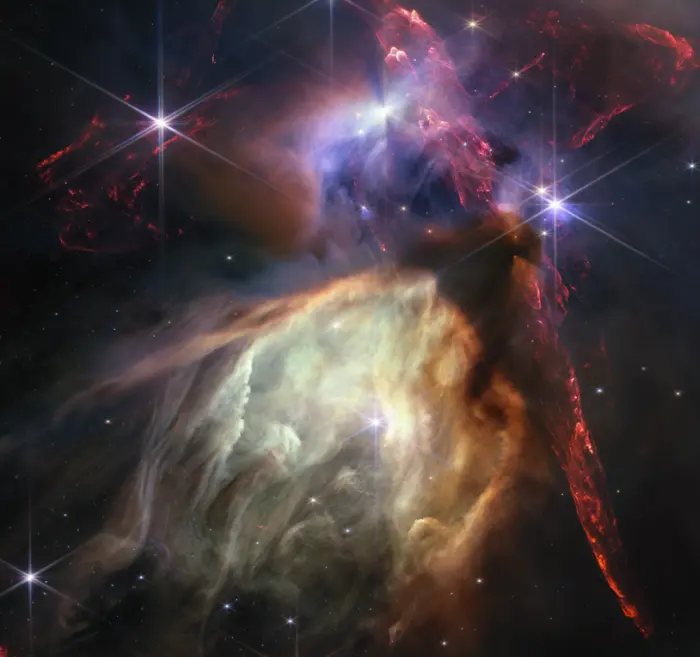
The first anniversary image from NASA’s James Webb Space Telescope displays star birth like it’s never been seen before, full of detailed, impressionistic texture. The subject is the Rho Ophiuchi cloud complex, the closest star-forming region to Earth. It is a relatively small, quiet stellar nursery, but you’d never know it from Webb’s chaotic close-up. Jets bursting from young stars crisscross the image, impacting the surrounding interstellar gas and lighting up molecular hydrogen, shown in red. Some stars display the telltale shadow of a circumstellar disk, the makings of future planetary systems. The young stars at the center of many of these disks are similar in mass to the Sun, or smaller. The heftiest in this image is the star S1, which appears amid a glowing cave it is carving out with its stellar winds in the lower half of the image. The lighter-colored gas surrounding S1 consists of polycyclic aromatic hydrocarbons, a family of carbon-based molecules that are among the most common compounds found in space. Image credit: NASA, ESA, CSA, STScI, Klaus Pontoppidan (STScI)
Location
The Rho Ophiuchi cloud complex appears south the polygon formed by the brightest stars in Ophiuchus. It appears near Antares, the brightest star in the constellation Scorpius and the 15th brightest star in the sky. For northern observers, Antares appears above the southern horizon during the summer months. The star is part of an asterism known as the Fish Hook, which outlines the Scorpion’s body and tail.
Rho Ophiuchi appears just north of Antares, in the direction of Yed Prior, and forms a triangle with Antares and Alniyat, one of the two relatively bright stars flanking the supergiant. Shining at magnitude 4.63, the Rho Ophiuchi star system is visible to the unaided eye but can be a challenging target from light-polluted areas.
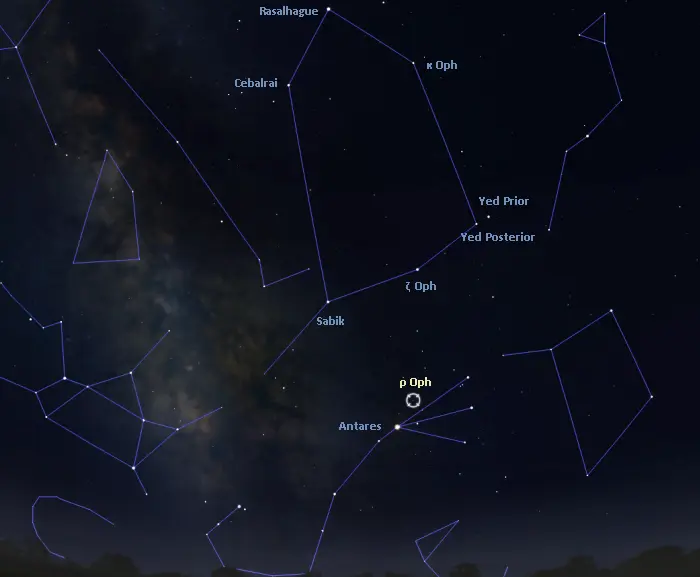
The location of the Rho Ophiuchi cloud complex, image: Stellarium
The bright globular cluster Messier 4 (M4) lies south of the Rho Ophiuchi cloud complex and appears in the same wide field of view as Rho Ophiuchi and Antares. The cluster has an apparent magnitude of 5.6 and can be easily observed in binoculars and small telescopes. The fainter globular cluster NGC 6144 lies a degree away from M4, closer to Antares.
The globular cluster Messier 80 (M80) appears west of Rho Ophiuchi, about halfway between Antares and Acrab in the Scorpion’s claws.
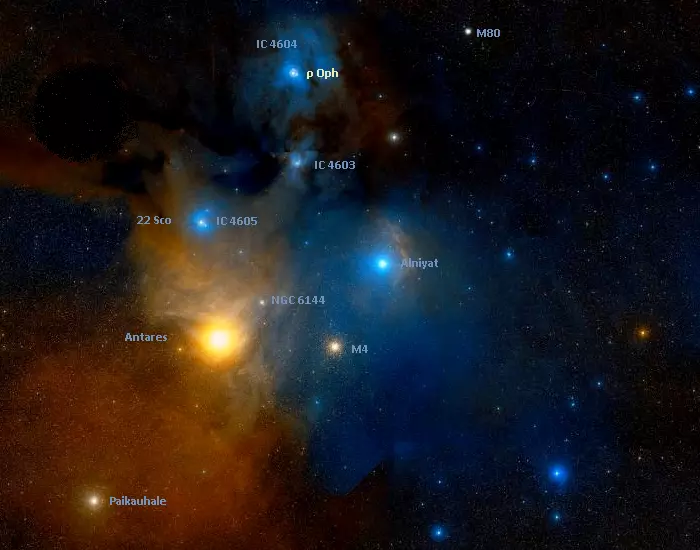
Rho Ophiuchi surroundings, image: Wikisky
The best time of the year to observe the Rho Ophiuchi molecular cloud and other deep sky objects in the constellation of Ophiuchus is during the month of July, when the constellation climbs higher above the horizon in the evening. As one of the 15 equatorial constellations, Ophiuchus is visible from most inhabited places on Earth for at least part of the year.
Rho Ophiuchi cloud complex
| Constellation | Ophiuchus |
| Right ascension | 16h 28m 06s |
| Declination | –24° 32.5′ |
| Apparent size | 4.5° × 6.5° |
| Distance | 460 light-years (140 parsecs) |
| Names and designations | Rho Ophiuchi cloud complex, Ophiuchus molecular cloud, Rho Ophiuchi molecular cloud, Rho Ophiuchi cloud, Integral 691, XSS J16271-2423 |
Images
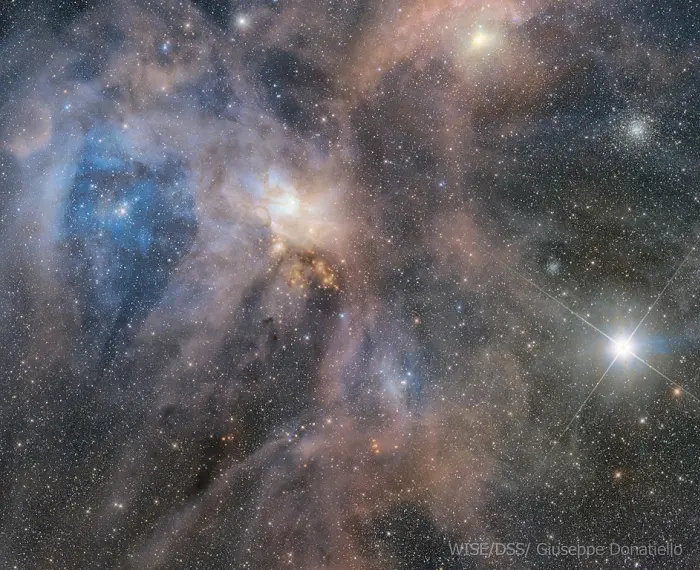
Antares (α Scorpii) and Rho Ophiuchi cloud complex Credit: WISE/DSS/ Giuseppe Donatiello (CC0 1.0)
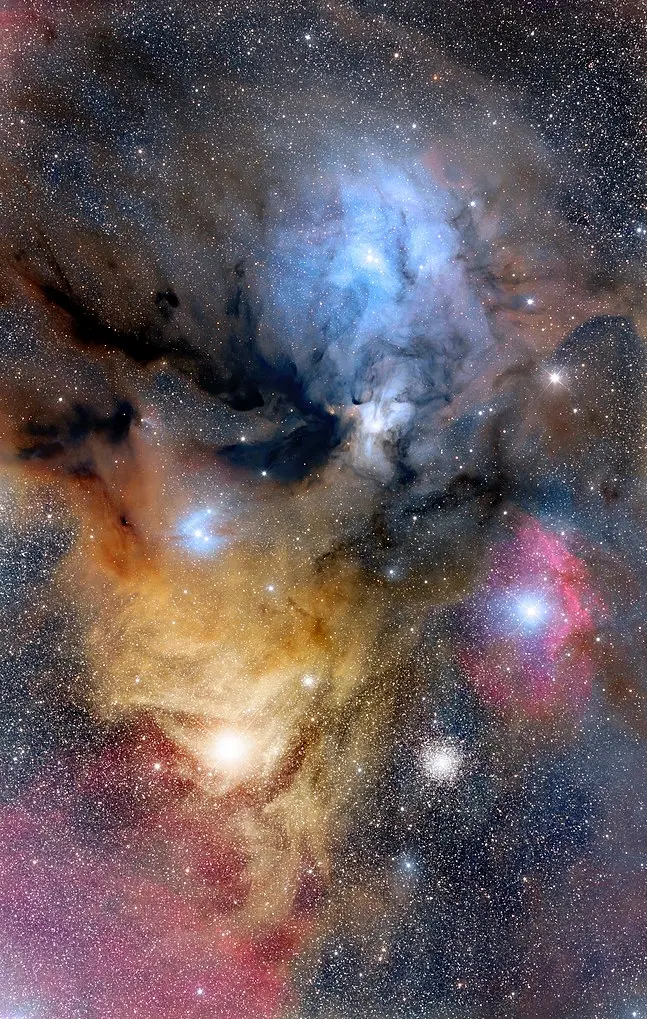
Nebulae in emission, reflection and absorption (dark clouds of dust) are included in this widefield image. Credit: Adam Block/Steward Observatory/University of Arizona (CC BY-SA 4.0)
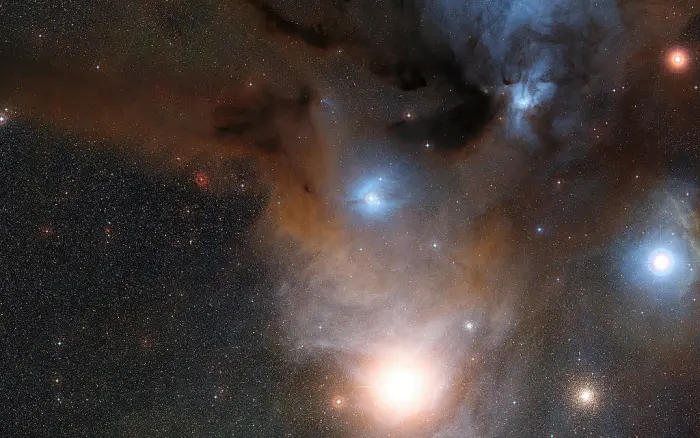
This wide-field view shows the star-forming region Rho Ophiuchi in the constellation of Ophiuchus (the Serpent Bearer), as seen in visible light. This view was created from images forming part of the Digitized Sky Survey 2. Image credit: ESO/Digitized Sky Survey 2 (CC BY 4.0)
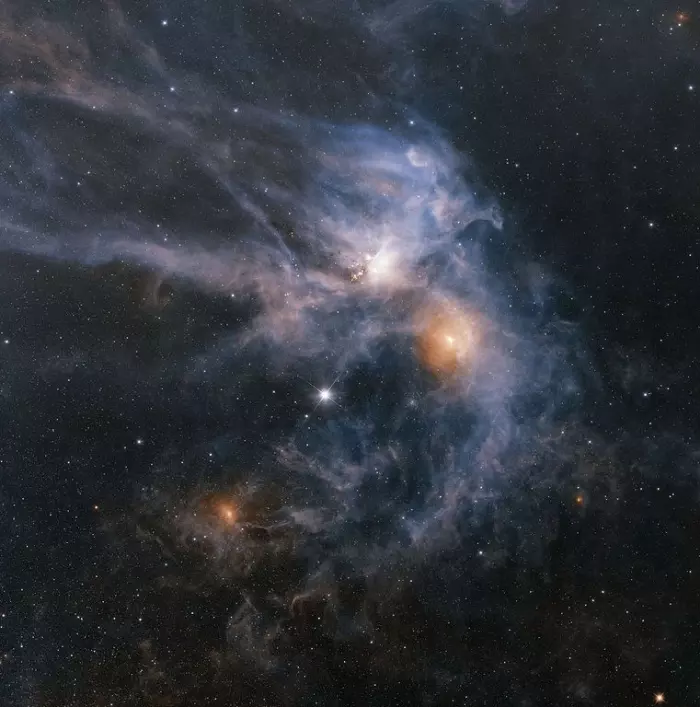
A vast cloud of dust famous for being one of the most colorful and most commonly photographed scenes in the night sky, the Rho Ophiuchi cloud complex takes on a wholly different appearance in infrared light from WISE. Here, where visible light reveals very little, instead silhouetting a dark and mysterious nebula, infrared wavelengths have no trouble penetrating this stellar dustbin. In the darkest reaches resides a stellar nursery, shown just above center, which glows intensely with newborn stars and young stellar objects. Just below and to the right of the nursery is a curtain of glowing dust surrounding Sigma Scorpii, appearing reddish in this image. Another smaller curtain of glowing reddish dust is seen surrounding Tau Scorpii to the lower left. The brightest star, appearing white and near center, is nearby Antares. To the lower left one may note the density of the stars is becoming quite high as the Milky Way’s center is approached. At the top, the glow of the zodiacal light is present. Image credit: Judy Schmidt (CC BY 2.0)
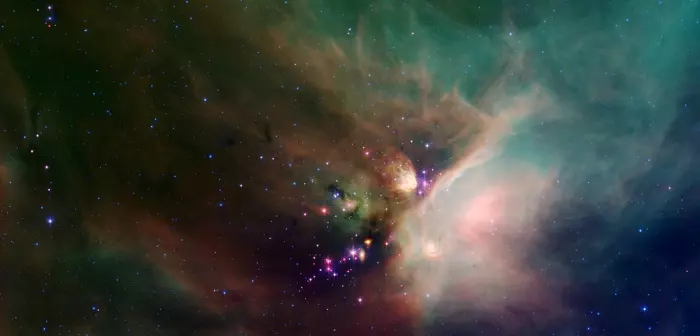
Cosmic dust clouds and embedded newborn stars glow at infrared wavelengths in this tantalizing false-color view from the Spitzer Space Telescope. Pictured is of one of the closest star forming regions, part of the Rho Ophiuchi cloud complex some 400 light-years distant near the southern edge of the pronounceable constellation Ophiuchus. The view spans about 5 light-years at that estimated distance. After forming along a large cloud of cold molecular hydrogen gas, newborn stars heat the surrounding dust to produce the infrared glow. An exploration of the region in penetrating infrared light has detected some 300 emerging and newly formed stars whose average age is estimated to be a mere 300,000 years — very young compared to the Sun’s age of 5 billion years. Image credit: NASA, JPL-Caltech, Harvard-Smithsonian CfA
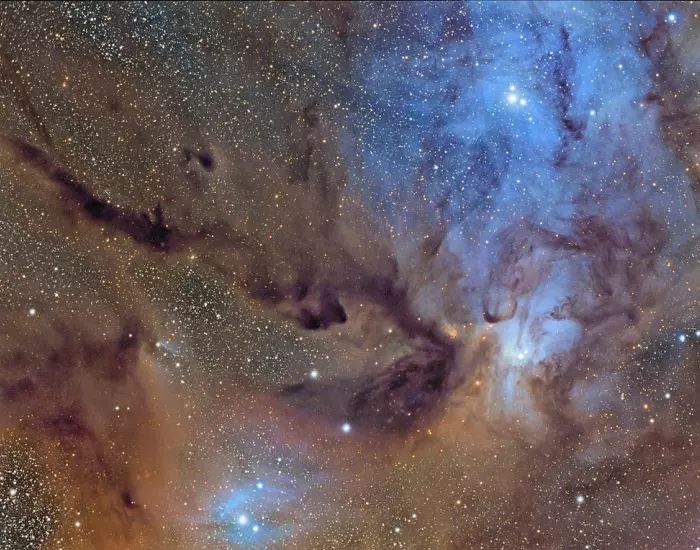
Rho Ophiuchi region, image credit: Leonardo Ciuffolotti, Matteo Collina, Riccardo De Benedictis, Giuseppe Donatiello, Rolando Ligustri (CC0 1.0)
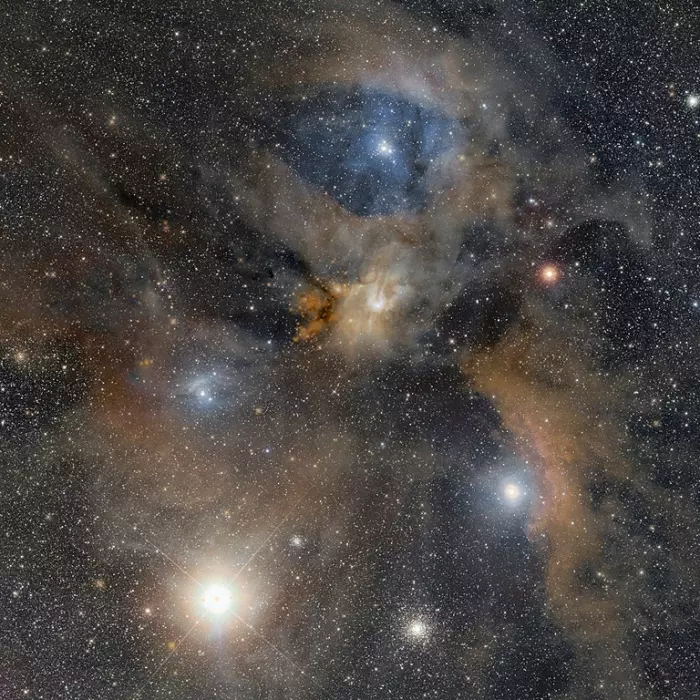
Rho Ophiuchi WISE DSS, image: Giuseppe Donatiello (CC0 1.0)